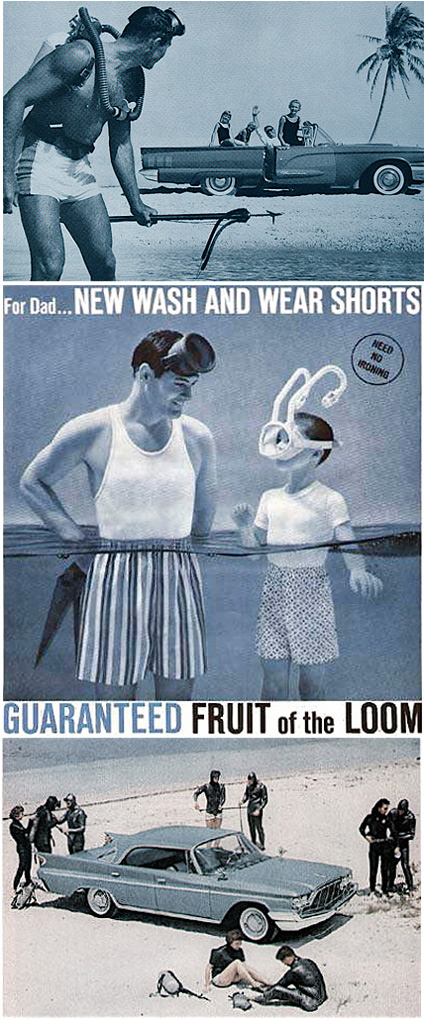Scanning Around with Gene: Scuba-Diver Chic
[Editor’s Note: Today we present the first installment of Gene Gable’s new column, Scanning Around with Gene, which is suspiciously like his old column, Heavy Metal Madness. All we know at this point is that Gene has promised to unleash his scanner on a variety of vintage graphics and dream up unusual themes that tie them together, however loosely. If this installment is any indication, he’s accomplished his goal.]
The ’60s was a great decade for good guys vs. bad guys. Cowboys and Indians were still viable entertainment, and the post-war interest in army heroes hadn’t faded. If you were a young boy looking for something a little more contemporary, there was the emerging field of spy adventure or space exploration, all inspired by popular television shows.
Though I never wanted to play cowboys and Indians, and my heart wasn’t in the army thing, I went through a “Man from Uncle” spy phase and had a short fantasy period where I was a character on “My Favorite Martian.” But it took re-runs of the TV show "Sea Hunt" to really catch my attention. From then on, I was fighting off sharks, saving trapped divers from certain doom, and slicing through the air hoses of bad guys on the bottom of the sea floor. All from the safety of the backyard swimming pool.
So of course I have a box full of diving brochures, catalogs, magazines, and other ephemera. I fired up the scanner to share some of my favorites and present several that are just plain bizarre.
As early as 1650, explorers used hand air pumps to attempt underwater breathing. During World War Two, Navy frogmen (named for the green rubber suits they wore) had devices that re-circulated breathing air by chemically scrubbing out the carbon dioxide and replacing it with oxygen. But it was Frenchmen Jacques-Yves Cousteau’s and Emile Gagnan’s 1942 modification of old car parts into the first self-contained underwater breathing apparatus that gave birth to a new sport. The two patented their device as the Aqua Lung, and a fast-growing industry was born.
By 1950, Aqua Lungs were being sold in the United States and, despite an image of being somewhat dangerous, were catching on quickly. Skin Diver Magazine first came out in 1951, a good indication that the market was growing and had potential for more mainstream adoption. Hollywood soon took notice, and movies featuring underwater action began appearing, like Manfish (below) in 1956.

The imagery of scuba diving got a big boost from 1958 to 1961, when the weekly TV show "Sea Hunt" had its popular run. Starring Lloyd Bridges as Mike Nelson, the show followed Mike’s adventures as he investigated crime, conducted scientific experiments, and fought bad guys under the sea.
Bridges became the first celebrity spokesman for the new sport of scuba diving and even scored an endorsement deal with equipment manufacturer AMF Voit, as shown in the 1960 ad below. Unlike many of the Hollywood movies, "Sea Hunt" provided a fairly realistic picture of the mechanics of scuba diving, despite a few cheats, such as using lighter-weight cardboard tanks for the above-water scenes.

Images of scuba divers began popping up in mainstream media, and underwater adventure took off as a theme for comic books and magazines, like these from 1960 and 1961.

There was a clear fascination for the underwater world as underwater photography became more common, and restless GIs, many now in their thirties, looked for new adventures. Cousteau’s book and movie The Silent World presented the underwater world as both fascinating and accessible.
The image of scuba divers was hardly what you would call “sexy” until 1955, when the Howard Hughes movie Underwater starring a busty Jane Russell premiered (see below). Largely an excuse to show Russell in a wet bathing suit — a stunt double did all the underwater scenes — the movie nonetheless opened the sport to women. Then in 1965, Sean Connery appeared in the James Bond movie Thunderball, proving that you could scuba dive while keeping your good looks and dignity intact. Equipment manufacturer Voit again worked out an endorsement deal, and a line of 007 dive gear was marketed for many years.

For some reason, scuba diving and knife fighting went together from the beginning, though I doubt many underwater fights ever really took place. If you could sneak up behind your victim and cut his air hose, there was nothing he could do but head for the surface. Sadly, modern equipment did away with the original two-hose regulators, so knife fights went out and spear guns came in as the preferred underwater weapon.
The following images are from Sea Hunt Comics (top) in 1960 and Frogman comics (bottom) in 1962. One of the challenges for artists unfamiliar with the intricacies of the sport was to realistically depict situations when, in most cases, they had never been under water themselves.

There’s a certain absurdity about the depiction of divers outside of the water, where the gear seems silly and out of place. Nonetheless, the following are two of my favorite scuba images, mostly because they take such good advantage of two-color printing. The top photo is from a 1961 Voit equipment catalog, and the bottom picture is the cover of a popular scuba-training book issued by the National Association of Underwater Instructors in 1962.

Without the ability to show much in the way of facial features, artists and photographers had no choice but to focus on the eyes. It’s common for images of scuba divers to have what can only be called “wild looks” behind their facemasks. Below are two examples, the top one from the 1966 movie Around the World Under the Sea (also starring Bridges), and the bottom one from a 1962 Sportsways equipment catalog.

In the ’60s, commercial advertisers became crazy about scuba diving, especially car manufacturers, who delighted in showing their new models parked near the shore while the owners readied themselves for underwater adventure. Eventually scuba divers found their way into almost every sort of product advertising, including, as seen below, cigarette and liquor ads — products that are hardly compatible with the sport.

Fairly early on, diving was depicted as a family activity, though it was mostly Dad who did the dangerous stuff. Below are three images from ’60s-era magazines. The first is from Avis Rent-a-Car, the second features Fruit of the Loom underwear, and the third shows just how many scuba divers you can cram into a new Desoto.

Everyone started getting into the underwater act, and the scuba diving industry tried its best to project an “anyone can do it” image. Many diving images were still inherently funny, thanks to the wetsuits and other gear (think Dustin Hoffman in The Graduate). Below is a goofy shot of father and son divers from Life Magazine’s popular “Miscellany” page. Below that, a happy couple frolic in the snow before plunging into the depths (date and source unknown).

In the beginning, most scuba images were in black and white, not just because that was the more popular form of photography, but because the gear was, well, mostly black and white. In fact, in the early episodes of "Sea Hunt," the producers used grey spray-paint on Mike Nelson’s wetsuits so he would stand out from the bad guys in the underwater scenes.
But it didn’t take long for manufacturers to add a little color to the sport. Make that a lot of color, as shown in the pictures below from the 1966 movie Around the World Under the Sea (top) and from a Totes rubber suit ad (bottom), exact date unknown. One reason for such bright colors (which are still popular today) is because the deeper you go under water, the less color you can see. Each foot of depth is like turning down the saturation feature in Photoshop. After about 30 or 40 feet, colors become very muted without artificial lighting.

As the sport grew, so did the need for modern package design, as illustrated in the images below from a dive-mask box (top) and a children’s Skin Diving Action Game (bottom), early ’60s.

Black and yellow was the dominant fashion trend in the early days, and if you were lucky enough to belong to an adventurous family, matching outfits were in store. Below is a happy scuba family from the 1962 catalog of the U.S. Divers Company (top) and a promotional image from a travel ad (bottom). Apparently airport security was a little less strict back then.

Somewhere in the 1970s, most advertisers stopped using scuba divers to promote their products, and the sport took on a rather nerdy image, which it still suffers from today. It’s unlikely that little boys want to grow up to be Mike Nelson anymore, and the bad guys now sport dirty bombs and vials of deadly viruses, not spear guns and knives.
Read more by Gene Gable.



I don’t think scuba diving adopted a “nerdy” image until the 90’s. Up until the late 80’s, scuba diving was often times used to titillate the male libido. Going back to the mid 60’s, there were lots of diving gear companies that featured sexy women in dive gear and most especially in body hugging wetsuits. By the time you got to the mid 80’s, it was hard to tell if the wetsuit ads you saw in Skin Diver looked like they were photographed by young men who thought they were doing a photo layout for Victoria’s Secret. Bosoms nearly spilling out of unzipped wetsuits were the order of the day.
And who can forget Jacqueline Bisset diving in that white t-shirt during the first ten minutes of The Deep? There was also a Hart To Hart episode where a male scuba diver is seduced by a female assassin, and let’s not forget the B-movie Piranha II: The Spawning, which had an underwater sex scene.
But by the end of the 80’s, that all went away. Political correctness swooped in, and the sport took on a very boring, very G rated image.
I see where Mike Meyers got so much parody out of some of the early advert gimmicks for his Austin Powers films? It makes one wonder if people were really allowed to practice medicine even with a license back then? Beauty bait in a sea of hungry men and monsters and Man this is good whiskey, but then they were 1st time breaking grounds for much of this stuff, trial and error. i can see Meyers saying “oH!! LOOK WERE LAUGHING IN THE SNOW WHILE WE HAVE DIVE GEAR ON!! OH! NO! LOOK I`M LAUGHING , WERE HAVING SO MUCH FUN here doing this!